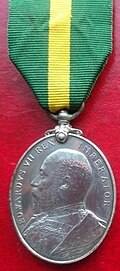Award criteria
The Territorial Force Efficiency Medal was awarded to non-commissioned officers and men for a minimum of 12 years service in the Territorial Force, providing they attended 12 annual training camps. [5] Previous service in other part-time forces including the Volunteer Force could count, [6] while war service counted double. [7] Bars were awarded for further periods of 12 years. [8]
The equivalent award for commissioned officers was the Territorial Decoration. [8] A recipient could wear both awards together, provided they completed the full periods of qualifying service for each. [9]
Description
The Territorial Force Efficiency Medal is an oval silver medal, 38 millimetres (1.5 inches) high and 31 millimetres (1.2 inches) wide.
The obverse depicts the bust of the reigning King in Field Marshall's uniform, facing left. Originally Edward VII was shown, with the legend, EDWARDVS VII REX IMPERATOR. In 1911 the image was changed to that of George V, the legend reading GEORGIVS V BRITT: OMN: REX ET IND: IMP:.
The reverse has a raised rim and bears the inscription "TERRITORIAL FORCE EFFICIENCY MEDAL" on four lines. [7]
The recipient's service number, rank, name, and unit were impressed on the edge of the medal.
The medal hangs from a ring suspension, attached to the medal by a claw fixing. The 32 millimetres (1.26 inches) wide ribbon was originally plain dark green with a central yellow stripe, but in December 1919 was changed to plain dark green with yellow edges. [8]
This page is based on this
Wikipedia article Text is available under the
CC BY-SA 4.0 license; additional terms may apply.
Images, videos and audio are available under their respective licenses.


